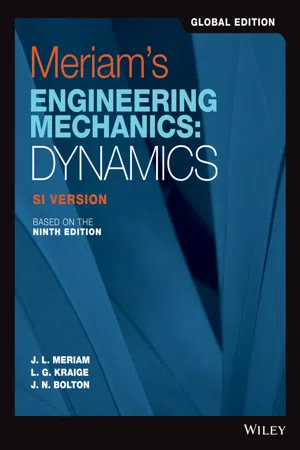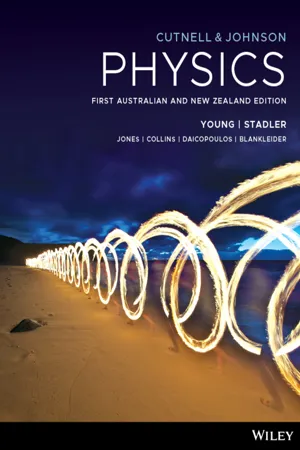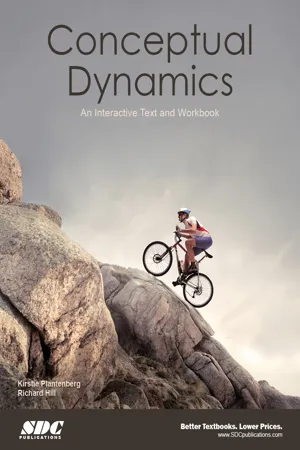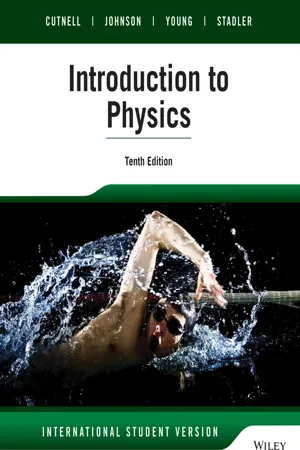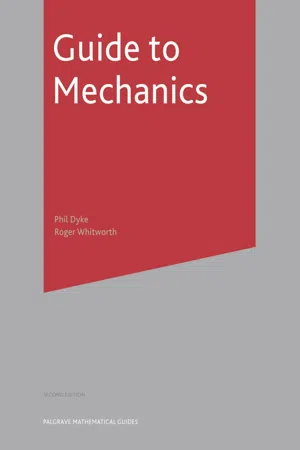Physics
Impact Forces
Impact forces refer to the forces that act on an object when it comes into contact with another object. These forces can cause a change in the object's motion or deformation. The magnitude and direction of impact forces depend on factors such as the mass, velocity, and material properties of the objects involved.
Written by Perlego with AI-assistance
Related key terms
1 of 5
9 Key excerpts on "Impact Forces"
- eBook - PDF
Meriam's Engineering Mechanics
Dynamics
- L. G. Kraige, J. N. Bolton(Authors)
- 2020(Publication Date)
- Wiley(Publisher)
This treatment included the direct use of Newton’s second law, the equations of work and energy, and the equations of impulse and momentum. We paid special attention to the kind of problem for which each of the approaches was most appropriate. Several topics of specialized interest in particle kinetics will be briefly treated in Section D: 1. Impact 2. Central-force motion 3. Relative motion These topics involve further extension and application of the fundamental principles of dynamics, and their study will help to broaden your background in mechanics. 3/12 Impact The principles of impulse and momentum have important use in describing the behavior of colliding bodies. Impact refers to the collision between two bodies and is characterized by the generation of relatively large contact forces which act over a very short interval of time. It is important to realize that an impact is a very complex event involving material deformation and recovery and the generation of heat and sound. Small changes in the impact conditions may cause large changes in the impact process and thus in the conditions immediately following the im-pact. Therefore, we must be careful not to rely heavily on the results of impact calculations. Direct Central Impact As an introduction to impact, we consider the collinear motion of two spheres of masses m 1 and m 2 , Fig. 3 ∕ 17 a , traveling with velocities v 1 and v 2 . If v 1 is greater than v 2 , collision occurs with the contact forces directed along the line of centers. This condition is called direct cen-tral impact . Following initial contact, a short period of increasing deforma-tion takes place until the contact area between the spheres ceases to increase. At this instant, both spheres, Fig. 3 ∕ 17 b , are moving with the same velocity v 0 . During the remainder of contact, a period of restoration occurs during which the contact area decreases to zero. - eBook - PDF
- W. J. Stronge(Author)
- 2018(Publication Date)
- Cambridge University Press(Publisher)
1.1.3 Interaction Force An interaction force and the impulse that it generates can be resolved into components normal and tangential to the common tangent plane. For particle impact the impulse is considered to be normal to the contact surface and due to short-range interatomic repulsion. For solid bodies however, contact forces arise from local deformation of the colliding bodies; these forces and their associated deformations ensure compatibility of displacements in the contact area and thereby prevent interpenetration or overlap of the bodies. In addition, a tangential force, friction, can arise if the bodies are rough and there is sliding in the contact area. Dry friction is negligible if the bodies are smooth. Conservative forces are functions solely of the relative displacement of the interact- ing bodies. In an elastic collision, the forces associated with attraction or repulsion are conservative (i.e., reversible); it is not necessary, however, for friction (a nonconservative force) to be negligible. In an inelastic collision the interaction forces (other than friction) are nonconservative, so that there is a loss of kinetic energy as a result of the cycle of compression and restitution that gives rise to the interaction force acting in the contact 3 1.1 Terminology of Two-Body Impact region. The energy loss can be due to irreversible elastic-plastic material behavior, rate-dependent material behavior, elastic waves trapped in the separating bodies, etc. 1.2 Classification of Methods for Analyzing Impact To classify collisions into specific types which require distinct methods of analysis, we need to think about the deformations that develop during collision, the distribution of these deformations in each of the colliding bodies, and how these deformations affect the period of contact. - eBook - PDF
- John D. Cutnell, Kenneth W. Johnson, David Young, Shane Stadler, Heath Jones, Matthew Collins, John Daicopoulos, Boris Blankleider(Authors)
- 2020(Publication Date)
- Wiley(Publisher)
We begin by applying the impulse–momentum theorem to a midair collision between two objects. The two objects (masses m 1 and m 2 ) are approaching each other with initial velocities v 01 and v 02 , as figure 7.6a shows. The collection of objects being studied is referred to as the ‘system’. In this case, the system contains only the two objects. They interact during the collision in part b and then depart with the final velocities v f1 and v f2 shown in part c. Because of the collision, the initial and final velocities are not the same. 176 Physics Two types of forces act on the system: 1. internal forces: forces that the objects within the system exert on each other 2. external forces: forces exerted on the objects by agents external to the system. FIGURE 7.6 (a) The velocities of the two objects before the collision are v 01 and v 02 . (b) During the collision, each object exerts a force on the other. These forces are F 12 and F 21 . (c) The velocities after the collision are v f1 and v f2 . m 1 m 2 v 01 F 12 v f1 v f2 F 21 v 02 (a) Before collision (b) During collision (c) After collision During the collision in figure 7.6b, F 12 is the force exerted on object 1 by object 2, while F 21 is the force exerted on object 2 by object 1. These forces are action–reaction forces that are equal in magnitude but opposite in direction, so F 12 = - F 21 . They are internal forces, since they are forces that the two objects within the system exert on each other. The force of gravity also acts on the objects, their weights being W 1 and W 2 . These weights, however, are external forces, because they are applied by the earth, which is outside the system. Friction and air resistance would also be considered external forces, although these forces are ignored here for the sake of simplicity. - eBook - PDF
- Richard C. Hill, Kirstie Plantenberg(Authors)
- 2013(Publication Date)
- SDC Publications(Publisher)
In the previous section on Conservation of Linear Momentum, we saw that the concept of conservation of linear momentum was useful in analyzing collisions. If we define the system to include both bodies involved in the collision, the internal interaction forces between the two bodies will be internal to the system and will cancel. If these were the only forces acting on the system in certain directions, the linear momentum of the system is conserved in these directions, though the energy of the system is often not conserved. By making a judicious choice of coordinate axes, we can also achieve conservation of the linear momenta of the individual particles in at least one direction. Conceptual Dynamics Kinetics: Chapter 9 – Particle Impulse & Momentum 9 - 24 Figure 9.4 - 2 shows an impact and two lines based on the impact geometry. The line of impact is drawn between the centers of mass of the two bodies and passes through the contact point. The plane of contact is perpendicular to the line of impact and resides at the contact between the two bodies. In general, the linear momentum of the system is conserved, but the momenta of the individual particles are not conserved in the direction of the line of impact. This is because the Impact Forces act in that direction. Assuming negligible friction, the momenta of the individual particles are conserved in the direction of the plane of contact since the Impact Forces have no components in this plane. Therefore, the components of the velocities of the particles in the plane of contact remain constant. When analyzing impacts, the following two simplifications are often assumed: 1. Because the internal Impact Forces, during the collision, are so large compared to the other external forces acting on the particles, the external forces can be neglected during the collision. 2. Because the duration of the impact is so short, the displacements of the particles during the collision do not need to be considered. - eBook - PDF
- John D. Cutnell, Kenneth W. Johnson, David Young, Shane Stadler(Authors)
- 2015(Publication Date)
- Wiley(Publisher)
We begin by applying the impulse–momentum theorem to a midair collision be- tween two objects. The two objects (masses m 1 and m 2 ) are approaching each other with initial velocities v 01 B and v 02 B , as Figure 7.6a shows. The collection of objects being stud- ied is referred to as the “system.” In this case, the system contains only the two objects. They interact during the collision in part b and then depart with the final velocities v f1 B and v f2 B shown in part c. Because of the collision, the initial and final velocities are not the same. Two types of forces act on the system: 1. Internal forces: Forces that the objects within the system exert on each other. 2. External forces: Forces exerted on the objects by agents external to the system. During the collision in Figure 7.6b, F 12 B is the force exerted on object 1 by object 2, while F 21 B is the force exerted on object 2 by object 1. These forces are action–reaction forces that are equal in magnitude but opposite in direction, so F 12 B 5 2F 21 B . They are internal forces, since they are forces that the two objects within the system exert on each other. The force m 1 m 2 v 01 F 12 v f1 v f2 F 21 v 02 (a) Before collision (b) During collision (c) After collision B B Figure 7.6 (a) The velocities of the two objects before the collision are v 01 B and v 02 B . (b) During the collision, each object exerts a force on the other. These forces are F 12 B and F 21 B . (c) The velocities after the collision are v f1 B and v f2 B . 178 Chapter 7 | Impulse and Momentum of gravity also acts on the objects, their weights being W 1 B and W 2 B . These weights, how- ever, are external forces, because they are applied by the earth, which is outside the system. Friction and air resistance would also be considered external forces, although these forces are ignored here for the sake of simplicity. - eBook - PDF
- John D. Cutnell, Kenneth W. Johnson, David Young, Shane Stadler(Authors)
- 2018(Publication Date)
- Wiley(Publisher)
For comparison, the graph also shows the magnitude F of the average force exerted on the ball during the time of contact. Figure 7.2 depicts other situations in which a time-varying force is applied to a ball. To describe how a time-varying force affects the motion of an object, we will introduce two new ideas: the impulse of a force and the linear momentum of an object. These ideas will be used with Newton’s second law of motion to produce an important result known as the impulse–momentum theorem. This theorem plays a central role in describing collisions, such as that between a ball and a bat. Later on, we will see also that the theorem leads in a natural way to one of the most fundamental laws in physics, the conservation of linear momentum. 175 176 CHAPTER 7 Impulse and Momentum If a baseball is to be hit well, both the magnitude of the force and the time of contact are important. When a large average force acts on the ball for a long enough time, the ball is hit solidly. To describe such situations, we bring together the average force and the time of contact, calling the product of the two the impulse of the force. DEFINITION OF IMPULSE The impulse J → of a force is the product of the average force F → and the time interval t during which the force acts: J → = F → ∆t (7.1) Impulse is a vector quantity and has the same direction as the average force. SI Unit of Impulse: newton · second (N · s) When a ball is hit, it responds to the value of the impulse. A large impulse produces a large response; that is, the ball departs from the bat with a large velocity. However, we know from experience that the more massive the ball, the less velocity it has after leaving the bat. - eBook - PDF
- John D. Cutnell, Kenneth W. Johnson, David Young, Shane Stadler(Authors)
- 2015(Publication Date)
- Wiley(Publisher)
4.1 | The Concepts of Force and Mass In common usage, a force is a push or a pull, as the examples in Figure 4.1 illustrate. In football, an offensive lineman pushes against his opponent. The tow bar attached to a speed- ing boat pulls a water skier. Forces such as those that push against the football player or pull the skier are called contact forces, because they arise from the physical contact between two objects. There are circumstances, however, in which two objects exert forces on one another even though they are not touching. Such forces are referred to as noncontact forces or action-at-a-distance forces. One example of such a noncontact force occurs when a diver is pulled toward the earth because of the force of gravity. The earth exerts this force even when it is not in direct contact with the diver. In Figure 4.1, arrows are used to rep- resent the forces. It is appropriate to use arrows, because a force is a vector quantity and has both a magnitude and a direction. The direction of the arrow gives the direction of the force, and the length is proportional to its strength or magnitude. The word mass is just as familiar as the word force. A massive supertanker, for instance, is one that contains an enormous amount of mass. As we will see in the next section, it is difficult to set such a massive object into motion and difficult to bring it to a halt once it is moving. In comparison, a penny does not contain much mass. The emphasis here is on the amount of mass, and the idea of direction is of no concern. Therefore, mass is a scalar quantity. During the seventeenth century, Isaac Newton, building on the work of Galileo, developed three important laws that deal with force and mass. Collectively they are called “Newton’s laws of motion” and provide the basis for understanding the effect that forces have on an object. Because of the importance of these laws, a separate section will be devoted to each one. - eBook - PDF
- John D. Cutnell, Kenneth W. Johnson, David Young, Shane Stadler(Authors)
- 2021(Publication Date)
- Wiley(Publisher)
For compari- son, the graph also shows the magnitude ¯ F of the average force exerted on the ball during the time of contact. Figure 7.2 depicts other situa- tions in which a time-varying force is applied to a ball. 192 CHAPTER 7 Impulse and Momentum To describe how a time-varying force affects the motion of an object, we will intro- duce two new ideas: the impulse of a force and the linear momentum of an object. These ideas will be used with Newton’s second law of motion to produce an important result known as the impulse–momentum theorem. This theorem plays a central role in describ- ing collisions, such as that between a ball and a bat. Later on, we will see also that the theorem leads in a natural way to one of the most fundamental laws in physics, the con- servation of linear momentum. If a baseball is to be hit well, both the magnitude of the force and the time of contact are important. When a large average force acts on the ball for a long enough time, the ball is hit solidly. To describe such situations, we bring together the average force and the time of contact, calling the product of the two the impulse of the force. DEFINITION OF IMPULSE The impulse → J of a force is the product of the average force ¯ → F and the time interval Δt during which the force acts: → J = ¯ → F Δt (7.1) Impulse is a vector quantity and has the same direction as the average force. SI Unit of Impulse: newton · second (N · s) When a ball is hit, it responds to the value of the impulse. A large impulse produces a large response; that is, the ball departs from the bat with a large velocity. However, we know from experience that the more massive the ball, the less velocity it has after leaving the bat. - eBook - PDF
- Philip Dyke, Roger Whitworth(Authors)
- 2017(Publication Date)
- Red Globe Press(Publisher)
CHAPTER 2 Forces 2.1 Force as a vector We now introduce the concept of force. When forces are studied alone, the study is called statics . When they are studies in conjunction with kinematics, then the area of study is called dynamics . If a body changes its velocity, we conclude that a force acts upon it. Consider the motion of parachutists falling from an airplane: 1 At first, they fall vertically downwards as a result of the force acting on them in that direction (Figure 2.1(a)). Their speed increases as they move downwards. The vertical force involved is principally the weight , which is the force of the Earth's attraction acting on the parachutist. In addition, there are resistance forces . Resistance forces will always oppose motion when they occur. 2 After the parachute opens (Figure 2.1(b)), the parachutist's speed will eventually reach a stage when it stops increasing. In this case, the velocity is no longer changing and all the forces acting on the body must cancel out. In fact, the magnitude of the resistance force is then equal to the magnitude of the weight (see Chapter 5). In the case of a body in a state of equilibrium , that is, at rest, the total force acting on the body must also be zero. Consider the following cases of a body P in equilibrium: Resistance Resistance Weight Weight (b) (a) Figure 2.1 Parachutists 27 Tension Weight (a) Reaction Reaction Weight Weight (c) Thrust Weight (b) (d) (e) Normal reaction Friction Push Normal reaction Friction Weight Weight (f) Figure 2.2 Bodies in equilibrium 1 When the body is suspended by a string to hang freely (Figure 2.2(a)), the weight is supported by an upward force in the string, the tension . 2 When the body is supported on a spring from below (Figure 2.2(b)), the weight is supported by an upward force in the spring, the thrust . 3 When the body is resting on a horizontal surface, the weight is supported by an upward force supplied by the surface, the reaction or normal reaction (Figure 2.2(c)).
Index pages curate the most relevant extracts from our library of academic textbooks. They’ve been created using an in-house natural language model (NLM), each adding context and meaning to key research topics.
